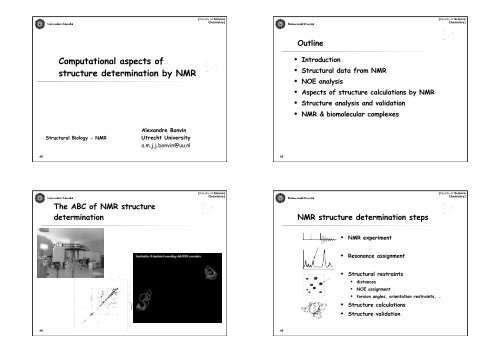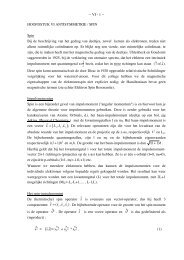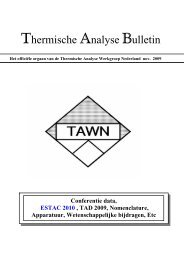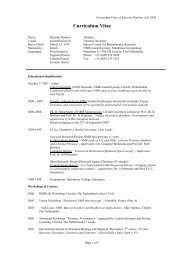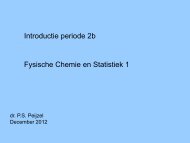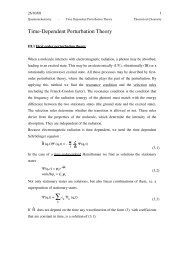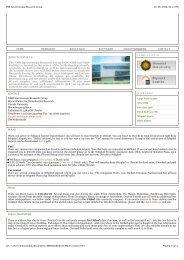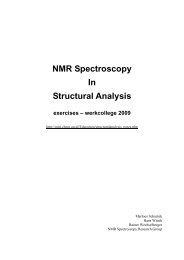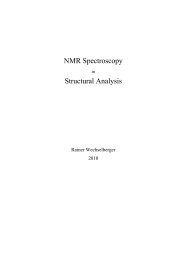1 Computational aspects of structure determination by NMR
1 Computational aspects of structure determination by NMR
1 Computational aspects of structure determination by NMR
You also want an ePaper? Increase the reach of your titles
YUMPU automatically turns print PDFs into web optimized ePapers that Google loves.
[Faculty <strong>of</strong> Science<br />
Chemistry]<br />
[Faculty <strong>of</strong> Science<br />
Chemistry]<br />
Outline<br />
<strong>Computational</strong> <strong>aspects</strong> <strong>of</strong><br />
<strong>structure</strong> <strong>determination</strong> <strong>by</strong> <strong>NMR</strong><br />
• Introduction<br />
• Structural data from <strong>NMR</strong><br />
• NOE analysis<br />
• Aspects <strong>of</strong> <strong>structure</strong> calculations <strong>by</strong> <strong>NMR</strong><br />
• Structure analysis and validation<br />
• <strong>NMR</strong> & biomolecular complexes<br />
Structural Biology - <strong>NMR</strong><br />
Alexandre Bonvin<br />
Utrecht University<br />
a.m.j.j.bonvin@uu.nl<br />
AB<br />
AB<br />
The ABC <strong>of</strong> <strong>NMR</strong> <strong>structure</strong><br />
<strong>determination</strong><br />
[Faculty <strong>of</strong> Science<br />
Chemistry]<br />
<strong>NMR</strong> <strong>structure</strong> <strong>determination</strong> steps<br />
[Faculty <strong>of</strong> Science<br />
Chemistry]<br />
• <strong>NMR</strong> experiment<br />
• Resonance assignment<br />
• Structural restraints<br />
• distances<br />
• NOE assignment<br />
• torsion angles, orientation restraints, …<br />
• Structure calculations<br />
• Structure validation<br />
AB<br />
AB
[Faculty <strong>of</strong> Science<br />
Chemistry]<br />
[Faculty <strong>of</strong> Science<br />
Chemistry]<br />
Outline<br />
<strong>NMR</strong> experimental observables providing<br />
structural information<br />
• Introduction<br />
• Structural data from <strong>NMR</strong><br />
• NOE analysis<br />
• Aspects <strong>of</strong> <strong>structure</strong> calculations <strong>by</strong> <strong>NMR</strong><br />
• Structure analysis and validation<br />
• <strong>NMR</strong> & biomolecular complexes<br />
• Backbone conformation from secondary chemical<br />
shifts (Chemical Shift Index- CSI)<br />
• Distance restraints from NOEs<br />
• Backbone and side chain dihedral angle<br />
restraints from scalar couplings<br />
• Orientation restraints from residual dipolar<br />
couplings<br />
AB<br />
AB<br />
[Faculty <strong>of</strong> Science<br />
Chemistry]<br />
[Faculty <strong>of</strong> Science<br />
Chemistry]<br />
Secondary chemical shifts<br />
Secondary chemical shifts<br />
• Chemical shifts deviations from random coil values contain<br />
information on secondary <strong>structure</strong><br />
• Chemical shift index (CSI) based on H α<br />
, C α<br />
, C β<br />
and C’<br />
secondary chemical shift (Wishart et al. J Biomol <strong>NMR</strong> 4, 171, 1994)<br />
H α<br />
C α<br />
C β<br />
C’<br />
AB<br />
AB
[Faculty <strong>of</strong> Science<br />
Chemistry]<br />
[Faculty <strong>of</strong> Science<br />
Chemistry]<br />
Chemical shifts analysis with TALOS<br />
Chemical shifts analysis with TALOS<br />
• Torsion Angle Likelihood Obtained from Shift and sequence<br />
similarity (Cornilescu et al. J. Biomol. <strong>NMR</strong> 13, 289, 1999)<br />
• Analysis <strong>of</strong> secondary chemical shift patterns in tripeptides <strong>by</strong><br />
comparison with a chemical shift database with known 3D<br />
<strong>structure</strong>s (Xray, resolution < 2.2 Å, ~3000 triplets)<br />
AB<br />
AB<br />
[Faculty <strong>of</strong> Science<br />
Chemistry]<br />
[Faculty <strong>of</strong> Science<br />
Chemistry]<br />
Scalar (J) couplings<br />
Distance information from NOEs<br />
• NOEs are the result <strong>of</strong> through space dipolar interactions,<br />
~ 1/r 6 --> max ~ 5Å<br />
• Derived from<br />
• 1H-1H (homonuclear) spectra<br />
2D<br />
3D<br />
1<br />
H 1<br />
H<br />
1<br />
H 1<br />
H 1<br />
H<br />
• 15 N- or 13 C-dispersed (heteronuclear) spectra<br />
3D<br />
1 H<br />
1<br />
H<br />
1 H<br />
1<br />
H<br />
• Can be used directly or indirectly as derived dihedral<br />
angle restraints using the Karplus relationship<br />
4D<br />
15<br />
N<br />
1 H<br />
1<br />
H<br />
13<br />
C<br />
1<br />
H<br />
1<br />
H<br />
1<br />
H<br />
1<br />
H<br />
• Problem <strong>of</strong> conformational averaging!<br />
15<br />
N<br />
13<br />
C<br />
13<br />
C<br />
13<br />
C<br />
15<br />
N<br />
15<br />
N<br />
AB<br />
AB
13C<br />
[Faculty <strong>of</strong> Science<br />
Chemistry]<br />
[Faculty <strong>of</strong> Science<br />
Chemistry]<br />
Orientational restraints from dipolar (D)<br />
couplings<br />
RDC restraints<br />
Reports angle <strong>of</strong> internuclear<br />
vector relative to<br />
magnetic field H o<br />
F2<br />
F1<br />
15<br />
N<br />
• Must accommodate multiple solutions→ multiple orientations<br />
F3<br />
1<br />
H<br />
15<br />
N<br />
Ho<br />
1<br />
H<br />
1<br />
H<br />
1<br />
H<br />
1 H<br />
• The RDCs are defined <strong>by</strong> their<br />
orientation with respect to the<br />
alignment tensor<br />
• Energy term in the <strong>structure</strong><br />
calculation E RDC<br />
= Σ k RDC<br />
(D exp<br />
-D calc<br />
) 2<br />
AB<br />
AB<br />
[Faculty <strong>of</strong> Science<br />
Chemistry]<br />
[Faculty <strong>of</strong> Science<br />
Chemistry]<br />
Outline<br />
NOE assignment<br />
• Introduction<br />
• Structural data from <strong>NMR</strong><br />
• NOE analysis<br />
• Aspects <strong>of</strong> <strong>structure</strong> calculations <strong>by</strong> <strong>NMR</strong><br />
• Structure analysis and validation<br />
• <strong>NMR</strong> & biomolecular complexes<br />
Resonance assignment<br />
NOE peak list<br />
Chemical shift table<br />
Assignment <strong>of</strong> NOE peaks<br />
AB<br />
AB
[Faculty <strong>of</strong> Science<br />
Chemistry]<br />
[Faculty <strong>of</strong> Science<br />
Chemistry]<br />
Structural restraints from NOEs<br />
• Selection <strong>of</strong> peaks<br />
• Assignment to proton<br />
pair<br />
• Calibration to<br />
distance<br />
From NOEs to distances<br />
NOE intensity A ij<br />
given <strong>by</strong>:<br />
with<br />
⎡⎡<br />
ρ 1<br />
σ 12<br />
... σ<br />
⎤⎤<br />
⎢⎢<br />
1N<br />
⎥⎥<br />
σ<br />
R =<br />
⎢⎢ 21<br />
ρ 2<br />
... σ 2N ⎥⎥<br />
⎢⎢ ... ... ... € ... ⎥⎥<br />
⎢⎢<br />
⎥⎥<br />
⎣⎣ ⎢⎢ σ N 1<br />
σ N 2<br />
... ρ N ⎦⎦ ⎥⎥<br />
A ij<br />
= [ exp( −τ m<br />
R )] ij<br />
and<br />
σ ij ≈ 1<br />
Series expansion:<br />
€<br />
A = exp(−τ m<br />
R ) = 1 − τ m<br />
R + τ 2<br />
m<br />
2 R 2 − ...<br />
r 6 f (motion)<br />
AB<br />
AB<br />
€<br />
[Faculty <strong>of</strong> Science<br />
Chemistry]<br />
[Faculty <strong>of</strong> Science<br />
Chemistry]<br />
Two-spin approximation<br />
(ISPA isolated spin-pair approximation)<br />
• From the series expansion and assuming:<br />
• no internal dynamics<br />
• no spin diffusion<br />
• short mixing times<br />
• Get calibration factor C cal from<br />
• reference distances<br />
• averages over all distances<br />
⎛⎛ ⎞⎞<br />
1<br />
d ij ≈ c<br />
⎜⎜ ⎟⎟<br />
cal ⎜⎜<br />
⎝⎝ A<br />
⎟⎟<br />
ij ⎠⎠<br />
⎛⎛ ⎞⎞<br />
A<br />
d ij ≈ d<br />
⎜⎜ ref ⎟⎟<br />
ref ⎜⎜<br />
⎝⎝ A<br />
⎟⎟<br />
ij ⎠⎠<br />
• Problems: approximate, introduces systematic errors<br />
1<br />
6<br />
1<br />
6<br />
Spin diffusion<br />
• Spin diffusion is major source<br />
<strong>of</strong> error in NOE derived<br />
distances (in particular for long<br />
mixing times and large molecules)<br />
• Indirect paths (---) are more<br />
efficient than direct path<br />
(1/r 6 ), --> underestimation <strong>of</strong><br />
distance --> wide error<br />
bounds necessary<br />
AB<br />
AB
[Faculty <strong>of</strong> Science<br />
Chemistry]<br />
[Faculty <strong>of</strong> Science<br />
Chemistry]<br />
Standard treatment <strong>of</strong> errors:<br />
upper and lower bounds<br />
• Loose upper and lower bounds are typically defined to<br />
account for errors such as peak integration, spin<br />
diffusion, internal dynamics, e.g.<br />
• distance ± 10,20%<br />
• Strong-medium-weak classification:<br />
Strong 1.8-2.8 Å<br />
Medium 1.8-3.5 Å<br />
Weak 1.8-4.5 Å<br />
(Very weak 1.8-5.5 Å)<br />
Distance restraints<br />
• S<strong>of</strong>t-square potential (Nilges) used to avoid large<br />
forces<br />
Force becomes constant<br />
>2Å violation<br />
AB<br />
AB<br />
[Faculty <strong>of</strong> Science<br />
Chemistry]<br />
[Faculty <strong>of</strong> Science<br />
Chemistry]<br />
Consequence <strong>of</strong> bounds<br />
• Bounds have to be large<br />
enough for cumulative error<br />
• Precise value not (too)<br />
important: even loose bounds<br />
restrict conformational space<br />
• May affect<br />
• precision <strong>of</strong> <strong>structure</strong><br />
• validation<br />
Outline<br />
• Introduction<br />
• Structural data from <strong>NMR</strong><br />
• NOE analysis<br />
• Aspects <strong>of</strong> <strong>structure</strong> calculations <strong>by</strong> <strong>NMR</strong><br />
• Structure analysis and validation<br />
• <strong>NMR</strong> & biomolecular complexes<br />
AB<br />
AB
[Faculty <strong>of</strong> Science<br />
Chemistry]<br />
[Faculty <strong>of</strong> Science<br />
Chemistry]<br />
Structure calculations<br />
• 3D <strong>structure</strong> has to satisfy:<br />
• experimental restraints<br />
• chemical knowledge<br />
• --> find the minimum <strong>of</strong> a target<br />
function that combines empirical<br />
force field with experimental<br />
restraints<br />
Outline<br />
• Introduction<br />
• Structural data from <strong>NMR</strong><br />
• NOE analysis<br />
• Aspects <strong>of</strong> <strong>structure</strong> calculations <strong>by</strong> <strong>NMR</strong><br />
• Empirical force field<br />
• Structure analysis and validation<br />
• <strong>NMR</strong> & biomolecular complexes<br />
AB<br />
AB<br />
[Faculty <strong>of</strong> Science<br />
Chemistry]<br />
[Faculty <strong>of</strong> Science<br />
Chemistry]<br />
Empirical force fields<br />
Bond stretching<br />
l<br />
• Rather simple description <strong>of</strong> the forces in the system<br />
• Energetic penalties associated with deviation from<br />
“reference” or “equilibrium” values<br />
• V potential = V bonds<br />
+ V angles<br />
+ V torsion<br />
+ V non-bonded<br />
• Various forms possible, e.g.:<br />
• Morse potential<br />
V(l) = D c<br />
{1 − e [− a (l − l 0 )] } 2<br />
<br />
<br />
Allows dissociation<br />
<strong>Computational</strong>ly more expensive<br />
V(l)<br />
• Harmonic potential<br />
V(l) = k 2 (l − l 0) 2 l 0<br />
l<br />
+ V exp<br />
Van der Waals electrostatic<br />
<br />
Most commonly used<br />
AB<br />
AB
[Faculty <strong>of</strong> Science<br />
Chemistry]<br />
[Faculty <strong>of</strong> Science<br />
Chemistry]<br />
Angle bending<br />
ϑ<br />
Torsional terms<br />
ω<br />
• Usually harmonic potential as for the bond stretching<br />
term<br />
V(θ) = k 2 (θ − θ 0) 2<br />
V(ϑ)<br />
• Describe rotation around bonds<br />
• The torsion angle ω around the B-C bond<br />
is defined as the angle<br />
between the ABC and<br />
BCD planes<br />
• V torsion should allow<br />
for multiple minima<br />
(rotameric states)<br />
ϑ<br />
AB<br />
AB<br />
[Faculty <strong>of</strong> Science<br />
Chemistry]<br />
[Faculty <strong>of</strong> Science<br />
Chemistry]<br />
Torsional terms<br />
ω<br />
Improper torsions and out-<strong>of</strong> plane bending<br />
motions<br />
• Usually expressed as a cosine series expansion:<br />
[ ]<br />
N<br />
V<br />
• V(ω) = n<br />
where V n is the “barrier height”<br />
2 1 + cos(nω − γ )<br />
∑<br />
n= 0<br />
O-CH 2 -CH 2 -O<br />
• Defined to maintain planarity <strong>of</strong> aromatic rings or<br />
chirality <strong>of</strong> atoms, e.g.:<br />
• Torsion C α -N-C-C β to maintain<br />
• tetrahedral conformation <strong>of</strong> C α<br />
35° for L-amino acids<br />
C ε1<br />
-35° for D-amino acids<br />
H δ1 C δ1<br />
• Torsion C δ1 -C γ -C ε1 -H δ1 to keep<br />
• aromatic hydrogen H δ1 in the plane<br />
C γ<br />
• <strong>of</strong> the ring<br />
C β<br />
• Usually implemented<br />
C α<br />
as harmonic potentials<br />
N<br />
C<br />
Tyr<br />
Single term: all minima equal<br />
Two terms: minima no longer equal<br />
AB<br />
AB
[Faculty <strong>of</strong> Science<br />
Chemistry]<br />
[Faculty <strong>of</strong> Science<br />
Chemistry]<br />
Electrostatic interactions<br />
• Atoms carry small partial charges<br />
• Electrostatic interactions<br />
calculated as the sum <strong>of</strong> interactions<br />
between pairs <strong>of</strong> point<br />
charges using Coulomb’s law<br />
• Slow decay as function <strong>of</strong> distance<br />
between atoms (~ 1/r)<br />
• Long-range contributions<br />
V elec<br />
=<br />
N<br />
N<br />
∑ ∑<br />
i= 1 j = 1<br />
q i<br />
q j<br />
4πε 0<br />
r ij<br />
q: partial charges<br />
ε: dielectric constant<br />
Van der Waals interactions<br />
• Attractive long-range forces<br />
• Repulsive short-range forces<br />
Repulsion<br />
between nuclei<br />
Attraction between<br />
induced dipoles from<br />
fluctuations in electron<br />
clouds (London forces)<br />
• Often expressed using the<br />
Lennard-Jones 12-6 function<br />
V L−J<br />
⎡⎡<br />
⎢⎢ ⎛⎛<br />
σ<br />
⎞⎞<br />
= 4ε ⎢⎢ ⎜⎜ ⎟⎟<br />
⎢⎢<br />
⎜⎜<br />
⎝⎝ r<br />
⎟⎟<br />
⎣⎣<br />
⎠⎠<br />
12<br />
σ: collision diameter<br />
ε: well depth<br />
−<br />
σ 6⎤⎤<br />
⎛⎛ ⎞⎞ ⎥⎥<br />
⎜⎜ ⎟⎟<br />
⎜⎜<br />
⎝⎝ r<br />
⎟⎟<br />
⎥⎥<br />
⎠⎠ ⎥⎥<br />
⎦⎦<br />
AB<br />
AB<br />
[Faculty <strong>of</strong> Science<br />
Chemistry]<br />
[Faculty <strong>of</strong> Science<br />
Chemistry]<br />
Force field: chemical information<br />
• topology:<br />
• atom names<br />
• atom types<br />
• atom masses<br />
• connectivity<br />
• parameters:<br />
• energy constants<br />
• ideal values<br />
€<br />
Derivatives <strong>of</strong> the energy function<br />
• Many molecular modelling techniques based on force fields<br />
require the derivative <strong>of</strong> the energy (i.e. the force) to<br />
be calculated with respect to the coordinates.<br />
• The derivative can be calculated using the chain rule:<br />
∂V(θ)<br />
∂x i<br />
• The force on atom i due<br />
to V(θ) is given <strong>by</strong>:<br />
= ∂V(θ)<br />
∂θ<br />
∂θ<br />
∂r ij<br />
∂r ij<br />
∂x i<br />
F i<br />
(θ ) = − ∂V(θ)<br />
∂x i<br />
AB<br />
AB
[Faculty <strong>of</strong> Science<br />
Chemistry]<br />
[Faculty <strong>of</strong> Science<br />
Chemistry]<br />
Outline<br />
• Introduction<br />
• Structural data from <strong>NMR</strong><br />
• NOE analysis<br />
• Aspects <strong>of</strong> <strong>structure</strong> calculations <strong>by</strong> <strong>NMR</strong><br />
• Empirical force field<br />
• Structure calculation methods<br />
• Structure analysis and validation<br />
• <strong>NMR</strong> & biomolecular complexes<br />
<strong>NMR</strong> <strong>structure</strong> calculation methods<br />
• Energy minimization ("build-up method", DIANA)<br />
• Metric matrix distance geometry (DISGEO, DG2)<br />
• Molecular dynamics methods:<br />
• Simulated annealing in Cartesian space from random<br />
<strong>structure</strong>s (X-PLOR, CNS)<br />
• Simulated annealing in torsion angle space from<br />
random <strong>structure</strong>s (X-PLOR, CNS, DYANA)<br />
AB<br />
AB<br />
[Faculty <strong>of</strong> Science<br />
Chemistry]<br />
[Faculty <strong>of</strong> Science<br />
Chemistry]<br />
Energy minimization (EM)<br />
Distance Geometry<br />
• At the minimum <strong>of</strong> the function f(x) the following is true:<br />
∂f<br />
∂x i<br />
= 0; ∂ 2 f<br />
∂x i<br />
2 > 0 AB<br />
• EM will only locate the<br />
nearest minimum<br />
• Can not cross energy<br />
barriers<br />
• Avoids "folding problem":<br />
• direct conversion from distances to (approximate)<br />
coordinates<br />
AB
[Faculty <strong>of</strong> Science<br />
Chemistry]<br />
[Faculty <strong>of</strong> Science<br />
Chemistry]<br />
Sir Isaac Newton<br />
(1642-1727)<br />
Classical mechanics<br />
• Newton’s laws <strong>of</strong> motion:<br />
1. A body moves in a straight line unless a<br />
force acts on it<br />
2. Force equal mass times acceleration<br />
3. To every action there is an equal reaction<br />
Classical mechanics<br />
• Molecular dynamics: generates successive configurations<br />
<strong>of</strong> the system <strong>by</strong> integrating Newton’s second law<br />
d 2<br />
dt 2 <br />
ri =<br />
<br />
F i<br />
m i<br />
with<br />
t 1<br />
t 2<br />
t 3<br />
€<br />
<br />
F i<br />
= − ∂V<br />
∂ r i<br />
€<br />
<br />
r (t 1<br />
)<br />
€<br />
<br />
r (t 2<br />
)<br />
<br />
F (t 1<br />
)<br />
<br />
v (t 1<br />
)<br />
<br />
v (t 2<br />
)<br />
AB<br />
AB<br />
€<br />
€<br />
[Faculty <strong>of</strong> Science<br />
Chemistry]<br />
[Faculty <strong>of</strong> Science<br />
Chemistry]<br />
Molecular dynamics<br />
Simulated annealing<br />
• Direction <strong>of</strong> motion<br />
depends on<br />
• forces (derived from force<br />
field and experimental<br />
restraints)<br />
• momentum<br />
• Temperature control and variation<br />
• Molecular dynamics can<br />
overcome local energy<br />
barriers<br />
AB<br />
AB
[Faculty <strong>of</strong> Science<br />
Chemistry]<br />
[Faculty <strong>of</strong> Science<br />
Chemistry]<br />
Simulated annealing with energy scaling<br />
Example <strong>of</strong> a <strong>NMR</strong> simulated annealing<br />
scheme<br />
• More flexible annealing schemes<br />
• Different variation <strong>of</strong><br />
different energy terms<br />
• E.g.:<br />
• E chem / E exp<br />
• E covalent / E exp / E nonbond<br />
AB<br />
AB<br />
[Faculty <strong>of</strong> Science<br />
Chemistry]<br />
[Faculty <strong>of</strong> Science<br />
Chemistry]<br />
SA example<br />
SA example: IL8 dimer<br />
AB<br />
AB
[Faculty <strong>of</strong> Science<br />
Chemistry]<br />
[Faculty <strong>of</strong> Science<br />
Chemistry]<br />
SA example: BPTI<br />
Torsion angle dynamics<br />
• dynamics time step dictated<br />
<strong>by</strong> bond stretching: waste <strong>of</strong><br />
CPU time<br />
• important motions are around<br />
torsions<br />
• ~ 3 degrees <strong>of</strong> freedom per<br />
AA (vs 3N atom<br />
for Cartesian<br />
dynamics)<br />
• Available in DYANA, X-PLOR,<br />
CNS, X-PLOR-NIH<br />
AB<br />
AB<br />
[Faculty <strong>of</strong> Science<br />
Chemistry]<br />
[Faculty <strong>of</strong> Science<br />
Chemistry]<br />
Calculation <strong>of</strong> <strong>structure</strong> ensembles<br />
Outline<br />
• Repeat calculation (20-200-xxx<br />
times)<br />
• Random variation <strong>of</strong> initial<br />
conditions (starting <strong>structure</strong>/<br />
velocities)<br />
• Obtain information on<br />
• uniqueness / different folds<br />
• "dynamics”<br />
• Introduction<br />
• Structural data from <strong>NMR</strong><br />
• NOE analysis<br />
• Aspects <strong>of</strong> <strong>structure</strong> calculations <strong>by</strong> <strong>NMR</strong><br />
• Structure analysis and validation<br />
• <strong>NMR</strong> & biomolecular complexes<br />
• Structure selection problem!<br />
AB<br />
AB
[Faculty <strong>of</strong> Science<br />
Chemistry]<br />
[Faculty <strong>of</strong> Science<br />
Chemistry]<br />
Validation <strong>of</strong> <strong>structure</strong>s: Why?<br />
• Structures should be reliable:<br />
• Satisfy experimental data<br />
• Good local and overall quality<br />
• Protein <strong>structure</strong>s are a valuable source for<br />
understanding biology<br />
• Structure based drug design<br />
• Homology modeling<br />
• --> Only “good” <strong>structure</strong>s are typically used<br />
Structure analysis and validation<br />
• Geometry (rmsd from idealized bonds, angles…)<br />
• Energetics (non-bonded, restraint energies…)<br />
• Violations analysis<br />
• Rmsd: pairwise (useful e.g. for clustering),<br />
from average, per residue rmsds<br />
• Stereochemical quality<br />
AB<br />
AB<br />
[Faculty <strong>of</strong> Science<br />
Chemistry]<br />
[Faculty <strong>of</strong> Science<br />
Chemistry]<br />
Validation <strong>of</strong> <strong>structure</strong>s<br />
Validation <strong>of</strong> <strong>structure</strong>s<br />
Bonded geometry<br />
Rotamers<br />
Electrostatics and hydrogen bonding<br />
AB<br />
Inter-atomic bumps<br />
AB
[Faculty <strong>of</strong> Science<br />
Chemistry]<br />
[Faculty <strong>of</strong> Science<br />
Chemistry]<br />
Validation <strong>of</strong> <strong>structure</strong>s<br />
Improving protein <strong>NMR</strong> <strong>structure</strong>s<br />
• Refinements in explicit or implicit water for final<br />
optimization<br />
• Better packing (van der Waals, electrostatic)<br />
• Better “outside” <strong>of</strong> proteins<br />
Backbone conformation<br />
• Refinement in explicit water:<br />
• Solvate the protein in water<br />
• Run restrained Molecular Dynamics simulation, including full<br />
electrostatics and van der Waals<br />
• Minimize the <strong>structure</strong>s<br />
Ramachandran plot<br />
AB<br />
AB<br />
[Faculty <strong>of</strong> Science<br />
Chemistry]<br />
[Faculty <strong>of</strong> Science<br />
Chemistry]<br />
Outline<br />
Protein-protein complexes<br />
• Introduction<br />
• Structural data from <strong>NMR</strong><br />
• NOE analysis<br />
• Aspects <strong>of</strong> <strong>structure</strong> calculations <strong>by</strong> <strong>NMR</strong><br />
• Structure analysis and validation<br />
• <strong>NMR</strong> & biomolecular complexes<br />
AB<br />
AB<br />
Understanding protein function<br />
requires to take the step from<br />
<strong>structure</strong> to interactions, the latter<br />
being much more numerous<br />
PNAS 100, 12123 (2003)<br />
Science 302, 1727 (2003)
[Faculty <strong>of</strong> Science<br />
Chemistry]<br />
[Faculty <strong>of</strong> Science<br />
Chemistry]<br />
<strong>NMR</strong>-based protein complexes<br />
Application example: lactose repressor<br />
• Typically based on intermolecular NOEs and residual<br />
dipolar couplings<br />
• Collection <strong>of</strong> restraints is a difficult and rather lengthy<br />
process<br />
• Requires rather complete assignments (side-chains) at the<br />
interface<br />
Headpiece<br />
Core<br />
domain<br />
Folding <strong>of</strong> a<br />
fourth helix<br />
upon binding<br />
To DNA<br />
• For efficient <strong>structure</strong> <strong>determination</strong> and large complexes,<br />
isotope labeling is a requisite<br />
Lewis et al. (1996). Science 271,1247.<br />
AB<br />
AB<br />
Solution <strong>structure</strong>s <strong>of</strong> the<br />
free and (SymL)DNA-bound lac<br />
headpiece solved <strong>by</strong> <strong>NMR</strong><br />
Spronk et al. (1999) Structure 7, 1483<br />
[Faculty <strong>of</strong> Science<br />
Chemistry]<br />
[Faculty <strong>of</strong> Science<br />
Chemistry]<br />
Isotope labeling helps a lot!<br />
Filter out all but protein-DNA NOEs<br />
13<br />
C, 15 N 13<br />
C, 15 N<br />
12<br />
C, 14 N<br />
12<br />
C, 14 N<br />
protein<br />
1 H<br />
12<br />
C, 14 N 12<br />
C, 14 N<br />
13<br />
C, 15 N<br />
13<br />
C, 15 N<br />
AB<br />
AB<br />
1 H<br />
DNA
[Faculty <strong>of</strong> Science<br />
Chemistry]<br />
[Faculty <strong>of</strong> Science<br />
Chemistry]<br />
Lac hp62VC-DNA(O1) restraints statistics<br />
Lac hp62VC-DNA(O1) docking<br />
protocol<br />
Protein (dimer)<br />
Intraresidue NOEs 514<br />
Sequential NOEs(|i-j| = 1) 419<br />
Medium range NOEs(1
[Faculty <strong>of</strong> Science<br />
Chemistry]<br />
[Faculty <strong>of</strong> Science<br />
Chemistry]<br />
Experimental sources: mutagenesis<br />
Experimental sources: H/D exchange<br />
Advantages/disadvantages<br />
Detection<br />
Advantages/disadvantages<br />
Detection<br />
+ Residue level information<br />
- Loss <strong>of</strong> native <strong>structure</strong><br />
should be checked<br />
- Binding assays<br />
- Surface plasmon resonance<br />
- Mass spectrometry<br />
- Yeast two hybrid<br />
- Phage display libraries, …<br />
+ Residue information<br />
- Direct vs indirect effects<br />
- Labeling needed for <strong>NMR</strong><br />
- Mass spectrometry<br />
- <strong>NMR</strong> 15 N HSQC<br />
AB<br />
AB<br />
[Faculty <strong>of</strong> Science<br />
Chemistry]<br />
[Faculty <strong>of</strong> Science<br />
Chemistry]<br />
Experimental sources:<br />
<strong>NMR</strong> chemical shift perturbations<br />
Experimental sources:<br />
<strong>NMR</strong> orientational data (RDCs, relaxation)<br />
Advantages/disadvantages<br />
+ Residue/atomic level<br />
+ No need for assignment if<br />
combined with a.a. selective labeling<br />
- Direct vs indirect effects<br />
- Labeling needed<br />
Detection<br />
- <strong>NMR</strong> 15 N or 13 C HSQC<br />
Advantages/disadvantages<br />
+ Atomic level<br />
- Labeling needed<br />
Detection<br />
- <strong>NMR</strong><br />
AB<br />
AB
Experimental sources:<br />
<strong>NMR</strong> saturation transfer<br />
[Faculty <strong>of</strong> Science<br />
Chemistry]<br />
HADDOCK: High Ambiguity Driven DOCKing<br />
<strong>NMR</strong> titrations<br />
<strong>NMR</strong> crosssaturation<br />
mutagenesis<br />
Amide protons at interface<br />
are saturated<br />
==> intensity decrease<br />
Cross-linking<br />
HADDOCK<br />
High Ambiguity Driven DOCKing<br />
H/D exchange<br />
A<br />
j<br />
i<br />
eff<br />
k d iAB<br />
x y<br />
z<br />
B<br />
Advantages/disadvantages<br />
+ Residue/atomic level<br />
+ No need for assignment if<br />
combined with a.a. selective labeling<br />
- Labeling (including deuteration) needed<br />
Bioinformatic predictions<br />
EFRGSFSHL<br />
EFKGAFQHV<br />
EFKVSWNHM<br />
LFRLTWHHV<br />
IYANKWAHV<br />
EFEPSYPHI<br />
<strong>NMR</strong> anisotropy data<br />
RDCs, para-restraints, diffusion anisotropy<br />
Other sources<br />
e.g. SAXS, cryoEM<br />
AB<br />
Dominguez, Boelens & Bonvin (2003). JACS 125, 1731 http://www.nmr.chem.uu.nl/haddock<br />
[Faculty <strong>of</strong> Science<br />
Chemistry]<br />
HADDOCK docking protocol<br />
AB
Protein biosynthesis and export<br />
Signal sequences control the entry <strong>of</strong> proteins to export pathways<br />
SecA - signal sequence recognition<br />
The 204-kDa SecA is the central player <strong>of</strong> the secretion machinery<br />
Crystal <strong>structure</strong> known, but no structural information<br />
for the the complex<br />
MMITLRKRRKLPLAVAVAAGVMSAQAMA<br />
Use the power <strong>of</strong> <strong>NMR</strong> to study this very large complex<br />
⎡⎡<br />
K<br />
r<br />
=<br />
⎢⎢<br />
⎢⎢⎣⎣<br />
R<br />
c<br />
2 ,<br />
para<br />
1<br />
1 1<br />
6 6<br />
⎛⎛<br />
3<br />
τ<br />
⎞⎞⎤⎤<br />
c<br />
⎞⎞⎤⎤<br />
c<br />
⎜⎜<br />
⎜⎜<br />
2 2 ⎟⎟<br />
⎟⎟<br />
4τ<br />
+<br />
2 2 ⎥⎥⎥⎥<br />
hτ<br />
⎟⎟<br />
⎟⎟<br />
⎝⎝ + ωhτ<br />
c c⎠⎠⎥⎥⎦⎦<br />
⎠⎠⎥⎥⎦⎦<br />
SecA - signal sequence recognition<br />
SecA - signal sequence recognition<br />
Use relaxation paramagnetic enhancement (RPE)<br />
to obtain inter-molecular distances<br />
Use relaxation paramagnetic enhancement (RPE)<br />
to obtain inter-molecular distances<br />
MMITLRKRRKLPLAVAVAAGVMSAQAMA<br />
C<br />
C<br />
Measure distances between ~ 10-28 Å<br />
Battiste & Wagner, Biochemistry 2000, 39, 5355.<br />
SecA perdeutarated, only methyl groups <strong>of</strong> Val, Ile and Leu protonated
SecA - signal sequence recognition<br />
SecA - signal sequence recognition<br />
We obtained 160 SecA-signal peptide distance restraints!<br />
Structure <strong>of</strong> the complex calculated with HADDOCK<br />
based on 160 SecA-signal peptide distance restraints!<br />
SecA - signal sequence recognition<br />
[Faculty <strong>of</strong> Science<br />
Chemistry]<br />
The End.<br />
hydrophobic<br />
acidic<br />
Arg8<br />
Arg6<br />
Lys10<br />
Lys7<br />
Ala19<br />
Val15<br />
Ala16<br />
Ala14 Val17<br />
Leu13<br />
Leu11<br />
Met22<br />
Structural basis for the promiscuous<br />
recognition<br />
… dual binding mode!<br />
Thank you for your attention!<br />
Gelis et al., Cell 2007<br />
AB
Rigid body energy minimization<br />
[Faculty <strong>of</strong> Science<br />
Chemistry]<br />
Semi-flexible SA refinement in<br />
torsion angle space<br />
[Faculty <strong>of</strong> Science<br />
Chemistry]<br />
AB<br />
AB<br />
[Faculty <strong>of</strong> Science<br />
Chemistry]<br />
Refinement in explicit water<br />
AB


